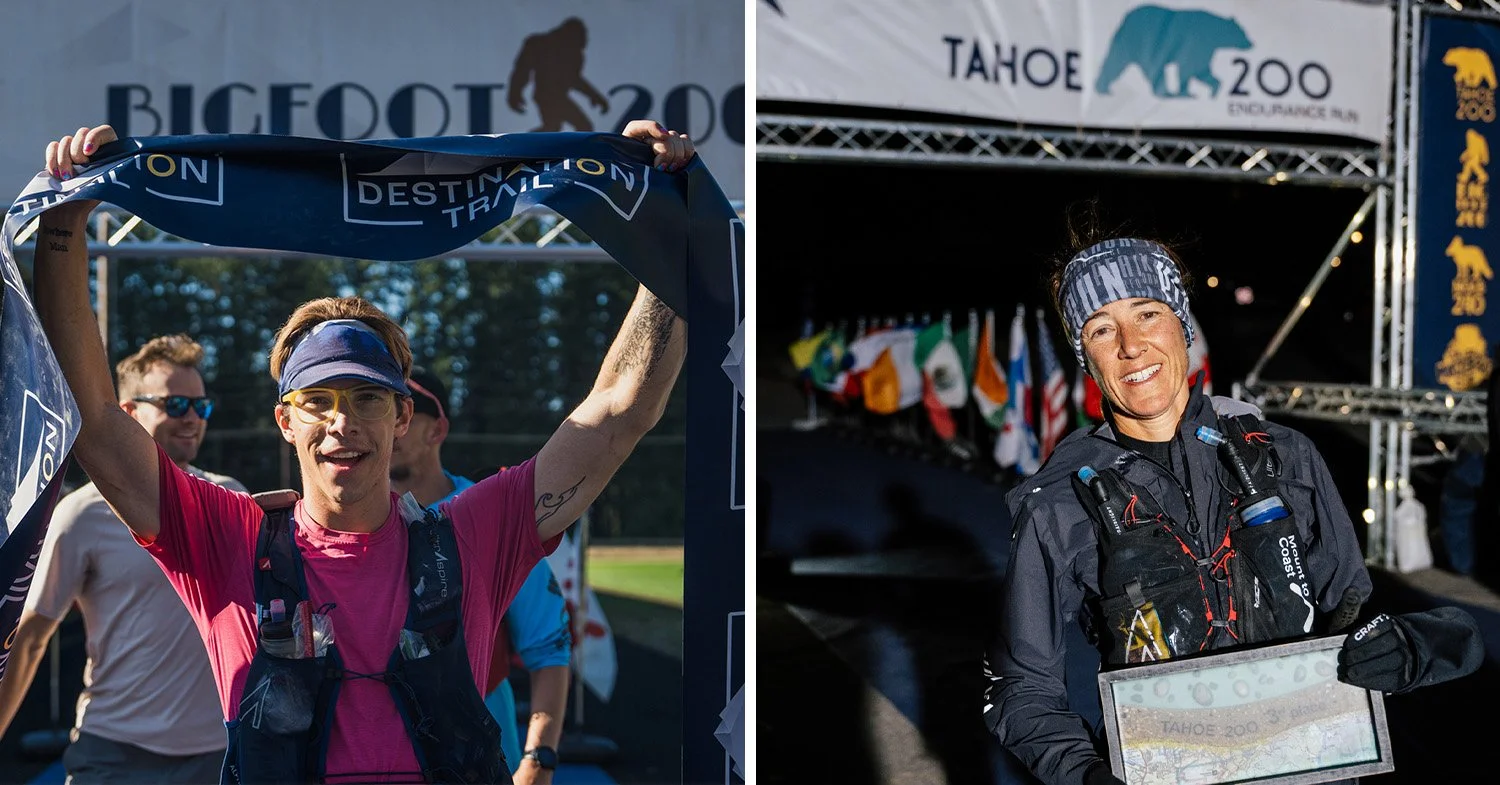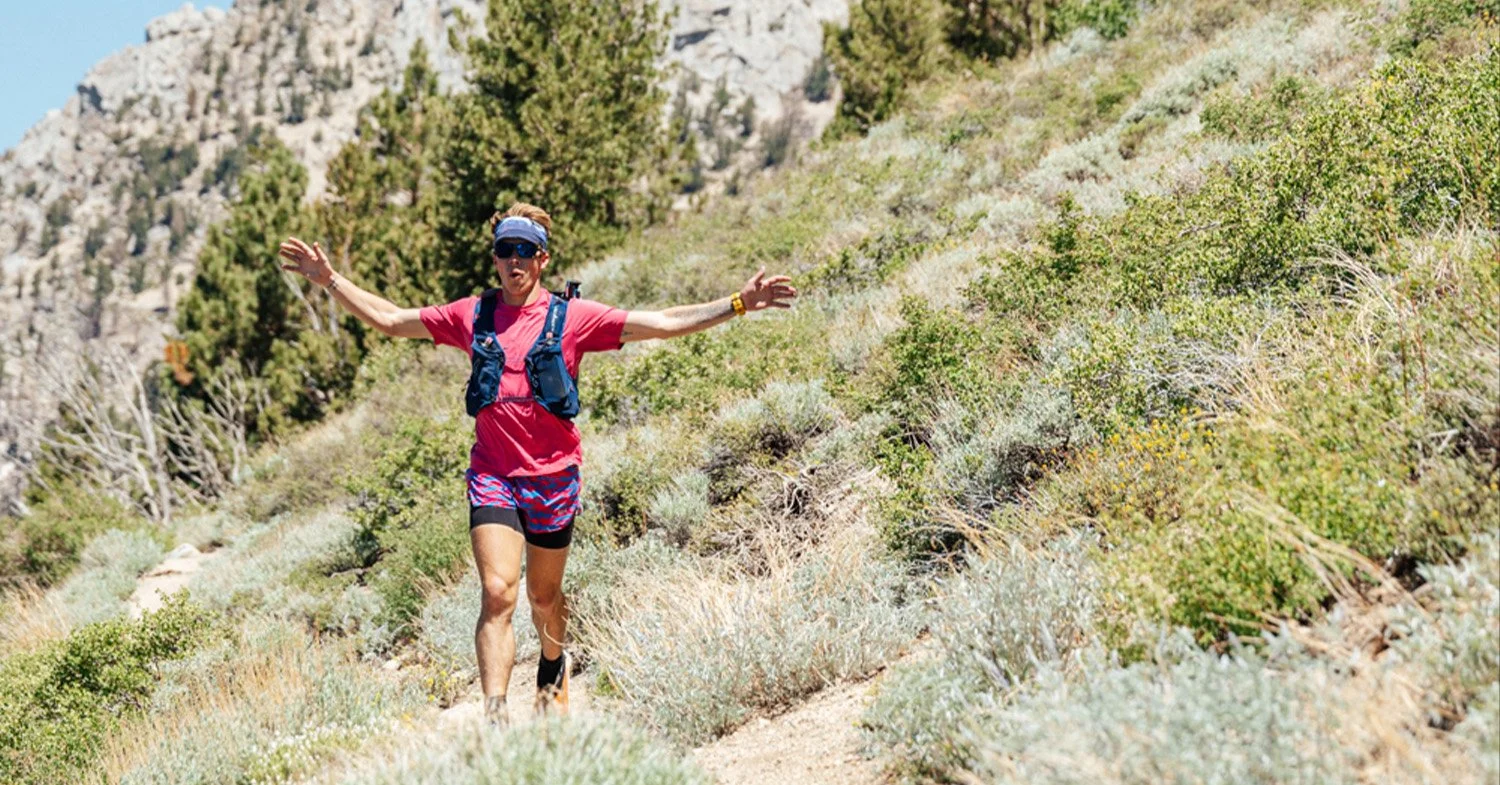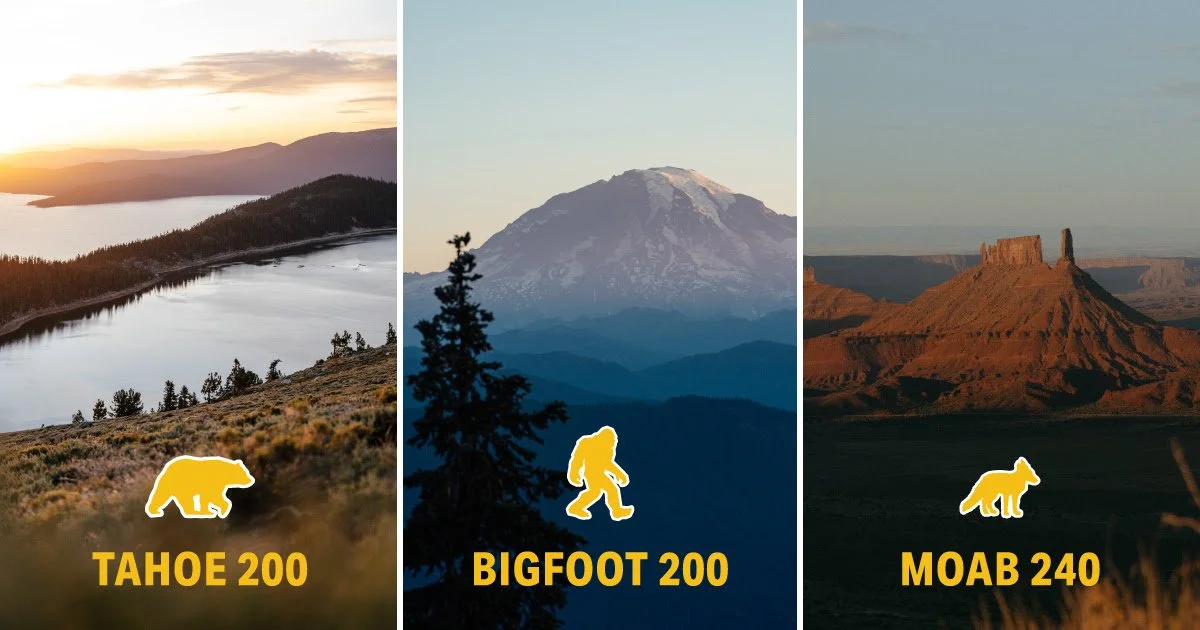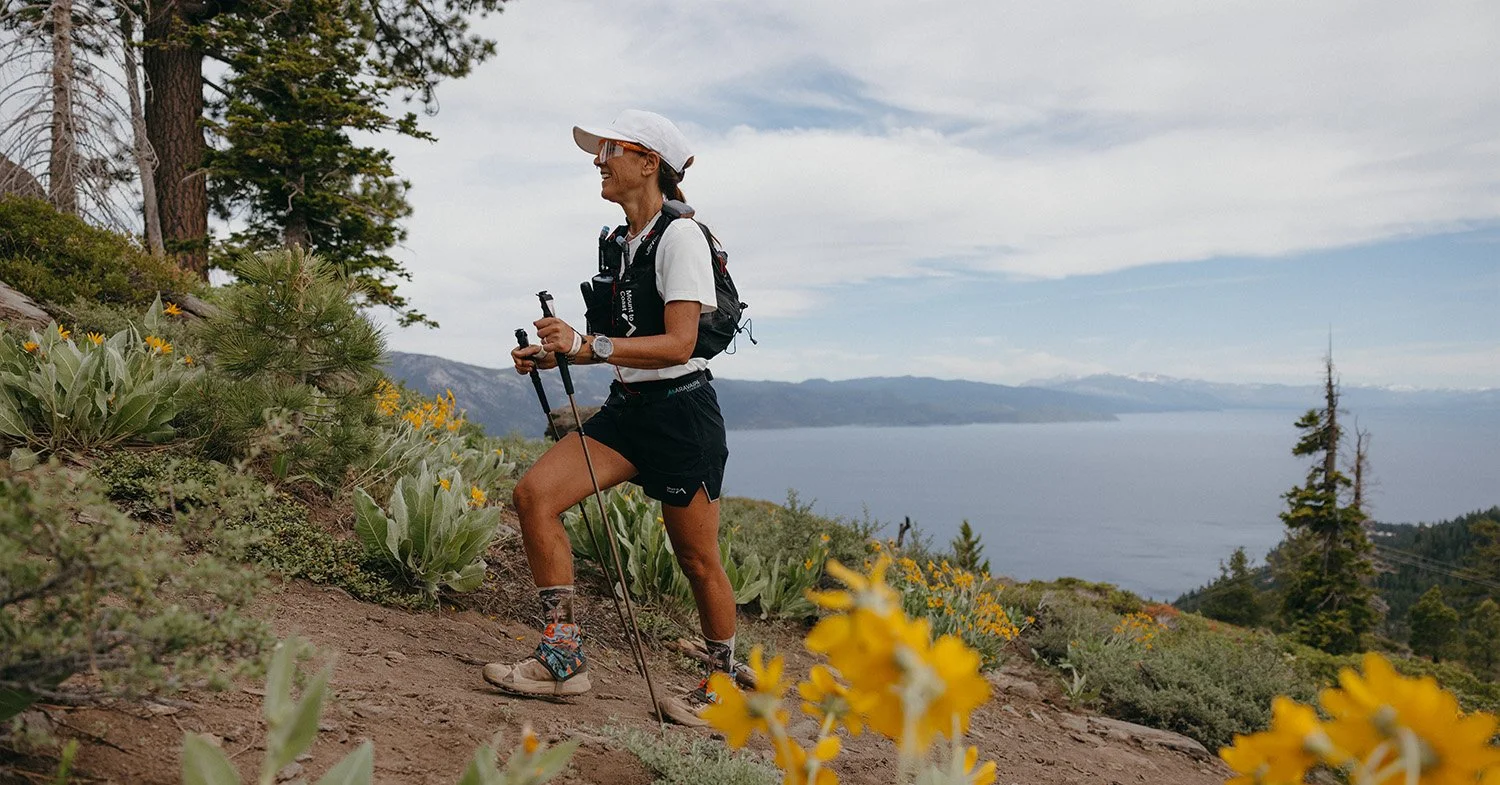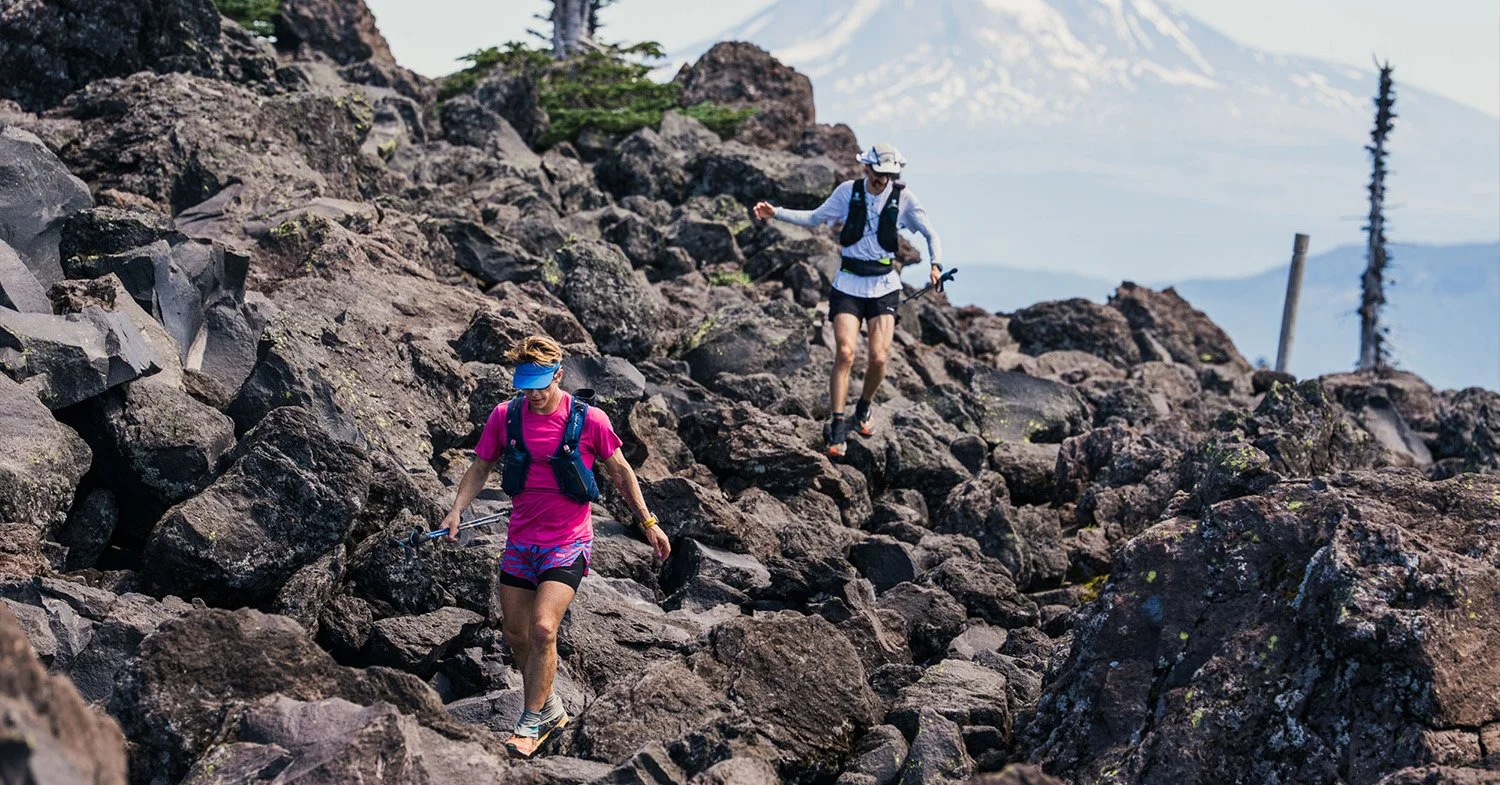Reflections from the 2025 Triple Crown Winners: Kilian Korth + Manuela Vilaseca
Key Takeaways
Kilian Korth and Manuela Vilaseca were the male and female winners of the 2025 Destination Trail Triple Crown. Both set new records, smashing previous records by several hours.
The Triple Crown is made up of three races: the Tahoe 200, Bigfoot 200, and Moab 240 — demanding a strategy where prioritizing health and recovery between races is more important than maximal training volume.
In the final race, marked by intense rainstorms, both runners used mental strategies like meditation, awareness, and quick decision-making to power them to the finish line.
Kilian at the Tahoe 200
For many ultra runners, completing a single 200-mile race would be the pinnacle of their running career. So, what about tackling three of them — the Tahoe 200, Bigfoot 200, and Moab 240 — all in the span of one epic race season? This year, 22 people achieved this incredible feat.
We sat down with this year's record-breaking male and female champions of the Destination Trail Triple Crown — Kilian Korth and Manuela (Manu) Vilaseca — to unpack how they managed to not only survive but thrive. Spoiler: it takes more than fast legs. It takes an iron will, a touch of self-aware humor, and a whole lot of strategic napping (or lack thereof).
Both athletes broke course records this year. Kilian finished with a time of 156:30:20, beating Mike McKnight’s 2019 record by about 7.5 hours. Manu completed the Triple Crown about 29 hours faster than the previous female record holder, Jessica Pekari. Manu’s time was 201:02:06, smashing the 2018 record.
The Allure of the Triple Crown: Three Unique Races
The very first question is always "Why?" For both Kilian and Manu, the motivation wasn't just the sheer scale of the challenge; it was the variety.
"The entire picture of the race series was fascinating to me from the get-go… They’re iconic races," Kilian, from Grand Junction, Colorado, shared. "You have the opportunity to push the bar over the course of one race season in multiple ways, because you have two mountainous races and a runnable race that test all your strengths as a runner.”
Manu, who is from Brazil but travels from Spain (where she now resides) to race, hit a point in her life where she felt like she’d accomplished everything she wanted to — until one of her students suggested a 200+ mile race, which eventually introduced her to the Triple Crown. After looking into it, she realized it was the perfect combination of a personal challenge and her love of exploration.
"What really intrigued me about it was that they are completely different races. It’s also an opportunity for me to visit places I’ve never been before, and to travel — and I love traveling."
Manu at the Tahoe 200
Here’s a rundown on each of the three races that make up the Triple Crown:
Tahoe 200: Lake Tahoe is an iconic trail-running destination in the Sierra Nevada Mountains, with miles of stunning single-track surrounding the largest alpine lake in the United States. Held each June, the Tahoe 200 takes runners through fields of wildflowers, aspen meadows, and past Star Lake—the highest alpine lake in the Tahoe Basin. It’s a high-altitude adventure through some of the most breathtaking terrain in North America.
Bigfoot 200: Rugged, remote, and relentlessly beautiful, the Bigfoot 200 is a true Pacific Northwest adventure. Held each August, this point-to-point course winds through the Cascade Mountains, taking runners across the Mount St. Helens blast zone, through lush Washington rainforests, and over multiple river crossings. Along the way, runners summit three peaks and experience some of the most wild and untamed terrain in the United States.
Moab 240: The Moab 240 is a breathtaking journey through Utah’s red-rock country, tracing trails that skirt Canyonlands and Arches National Parks and wind deep into Bears Ears National Monument. Held in mid-October, this 240-mile route crosses desert washes, climbs over high mountain passes crossing two mountain ranges, and runs along vast slickrock expanses glowing in shades of orange and crimson. It’s a sweeping exploration of the American Southwest’s most striking terrain.
Kilian at the Bigfoot 200
The Winners’ Secret Sauce: Recovery > Training
In the Triple Crown, what makes or breaks you isn’t how you train for the first race; it’s what you do in the short windows between each event.
Kilian and Manu had similar, but different strategies.
“I was prioritizing showing up on race day healthy as opposed to fitting in as much training as possible,” Kilian said. He doubled down on sleep and his diet, and didn’t compromise the small things. “Safety first, training second,” was his overall approach. He thinks this resulted in higher quality training than if he had simply pushed for volume.
Manu took a similar, but even more aggressive approach, prioritizing health over mileage. "My philosophy was to do less and less," she explained. She felt no need to obsess about weekly mileage when her body needed to recover. In fact, her longest run between Bigfoot and Moab was only a half marathon.
Manu at the Bigfoot 200
“Instead of thinking of weekly miles, I thought of hours of activity, and I added everything to it, like walking the dogs,” she says. This approach paid off, allowing her to get to each starting line "feeling healthy".
She also prioritized her mental health, removing distractions like social media and Strava. “I didn’t want to look at either of them because then start comparing yourself, and that's where all the doubts will come. That's when you're not going to trust your process.”
Mental Fortitude: Tricks, Mantras, and Resets
In a 200+ mile race, every runner hits at least one serious low. Mental stamina becomes your most important piece of mandatory gear. This was especially true with the intense rains at this year’s race.
“It was 16 miles of very soupy, slippery mud, followed by another 18 miles straight of very sticky and very slippery mud," said Kilian. "What are you gonna do when your feet weigh 10 pounds a piece? You’re not even running at that point.”
Kilian, who slept only about 11 minutes total during his almost 59-hour Moab 240 effort, relied on simple, actionable mental tricks. For example, he talks to himself out loud, saying things like, “I can do this.”
When both running and walking start to hurt (and they will!), he asks: "Why not run if they’re both painful and then be done sooner?" In Moab, he used a "metronome strategy" on runnable sections, focusing on turnover and telling himself, "I am a metronome. That’s all I am.”
He also credits meditation with helping him get through low points during the race. “If you're able to take some deep breaths and focus on sensations that aren't actually bad, it helps,” he says. “I tell the athletes I coach, ‘Focus on your arms. Your arms aren't going to hurt that bad.’ And sometimes I'll pretend that my arms are what's moving me forward.”
Manu at the Moab 240
Manu’s experience in Moab — which saw heavy rain and slippery, soupy mud — led to her most powerful mantra, gifted to her by a friend: "The weather is going to make people soft, but not you." She grabbed onto this idea and carried it throughout the entire race.
Manu also credits her mindset with helping her get through these longer races. “Be present and don’t think of all the way you have to go; instead, focus on being in the moment and what you can control.” When she hit a low point at the first aid station, she did exactly that. Instead of rushing herself to get back to the race, she told herself, “Just rest, eat, slow down, and take it easy.”
When she felt low at the second aid station in Moab, she didn't wait; she decided, "I need a reset," changing her clothes and starting the race over again in her mind.
The Finish Line: Relief, Gratitude, and the Post-Race Fog
Kilian’s immediate feeling while approaching the finish line was one of overwhelming relief. When he crossed the finish line, he immediately thought: “Thank god I’m done running.” His race was compounded by conditions in Moab that made forward movement miserable.
He didn't truly grasp the magnitude of his achievement until a few days later when he woke up, saw his three finisher mugs — for the Tahoe 200, Bigfoot 200, and Moab 240 — hanging on his coffee station, and had the realization: "Oh, wow. I actually did it." His ultimate feeling was an immense amount of gratitude for the community and family who supported him, even showing up to see him cross Moab’s finish line.
Kilian at the Moab 240
Manu had a bittersweet feeling. “I was very, very, very happy, but also felt sad that a very special chapter had ended,” she said. Her crew found it hard to believe she enjoyed the end of the race because she was struggling to walk. For her, the best part wasn't the broken record — because, as she says, "records are there and they will be broken" — but everything she lived and learned.
The Future of the 200+ Mile Race Distance
Both champions agree that the ultra-long distance is still wide open for new records and evolving strategies.
Kilian credits his time improvement over the previous men’s record not only to his effort but to "sports nutrition and just experimentation at the distance." He points out that as races get more competitive, times will naturally drop because athletes will have no option but to keep pushing. He also sees different sleep strategies emerging: his approach, which opts for a slower, consistent pace and minimal sleep versus others who sleep more and move faster while awake.
Manu agreed that right now, training is "very open for ideas" with no one single winning formula. She thinks this is what makes the sport fun and playful — building a strategy with elements like sleep, fueling, and mental control. "The longer the distance, the more intelligent you have to be when you’re racing," she asserts. “It comes down to making intelligent decisions, and making them fast.”
Follow Kilian on Instagram (@runtoughmindset) and keep an eye out for an upcoming documentary about Kilian’s Moab journey in early 2026, called “Forged in Failure.”
Follow Manu on Instagram (@manuvilaseca) or inquire about coaching.
Are you ready to discover your own strength and spirit on the trail? Learn more about running the Triple Crown here.

